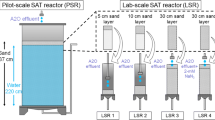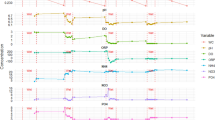Abstract
Through the use of innovative analytical tools, the removal/transformation of wastewater effluent organic matter (EfOM) have been tracked through soil aquifer treatment (SAT). While the total amount of EfOM is significantly reduced by SAT, there are trends of shorter term versus longer term removals of specific EfOM fractions. The preferential removal of non-humic components (e.g., proteins, polysaccharides) of EfOM occurs over shorter travel times/distances while humic components (i.e., humic substances) are removed over longer travel times/distances, with the removal of both by sustainable biodegradation. Dissolved organic nitrogen (DON), a surrogate for protein-like EfOM, is also effectively removed over shorter term SAT. There is some background humic-like natural organic matter (NOM), associated with the drinking water source within the watershed, that persists through SAT. While most effluent-derived trace organic compounds are removed to varying degrees as a function of travel time and redox conditions, a few persist even through longer term SAT.
Similar content being viewed by others
References
Awwa Research Foundation (2001). Investigation on soil-aquifer treatment for sustainable water reuse. Denver, Colorado.
Drewes, J. E., & Fox, P. (2001). Source water impact model (SWIM). Water Science & Technology, 43 (10), 267–275.
Drewes, J, Heberer, T., Rauch, T., & Reddersen, K. (2003). Fate of pharmaceuticals during ground water recharge. Ground Water Monitoring & Remediation, 23 (3), 64–72.
Grünheid, S., Amy, G., & Jekel, M. (2005). Removal of bulk dissolved organic carbon and trace organic compounds by bank filtration and artificial recharge. Water Research, 39, 3219–3228.
Mansell, J., & Drewes, J. (2004). Fate of steroidal hormones during soil aquifer treatment. Ground Water Monitoring & Remediation, 24 (2), 94–101.
Mansell, J., Drewes, J., & Rauch, T. (2004). Removal mechanisms of endocrine disrupting compounds (steroids) during soil aquifer treatment. Water Science & Technology, 50 (2), 229–237.
Author information
Authors and Affiliations
Corresponding author
Rights and permissions
About this article
Cite this article
Amy, G., Drewes, J. Soil Aquifer Treatment (SAT) as a Natural and Sustainable Wastewater Reclamation/Reuse Technology: Fate of Wastewater Effluent Organic Matter (EfOM) and Trace Organic Compounds. Environ Monit Assess 129, 19–26 (2007). https://doi.org/10.1007/s10661-006-9421-4
Received:
Revised:
Accepted:
Published:
Issue Date:
DOI: https://doi.org/10.1007/s10661-006-9421-4




